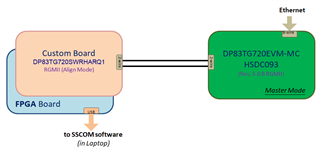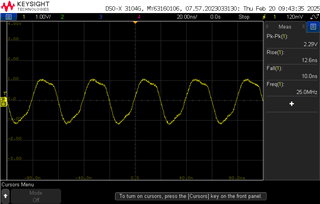Other Parts Discussed in Thread: DP83TG720R-Q1, DP83TG720EVM-MC, DP83TG720S-Q1

Our team is evaluating the DP83TG720R-Q1 Ethernet PHY using a custom-designed board and the DP83TG720EVM-MC evaluation board.
The setup is as follows:
- Evaluation Board (EVM) Connection: The DP83TG720EVM-MC is connected to Ethernet.
- Custom Board Setup:
- The custom board also uses the DP83TG720R-Q1.
- The custom board is connected to an FPGA, which serves as the MAC interface.
- The FPGA is connected to a laptop via USB, and SSCOM software is used to monitor communication.
- PHY ID Recognition:
- The PHY is correctly detected in SSCOM, meaning the MDIO interface is working.It gives following msg:
Configuring network interfaces...ZYNQ GEM: ff0e0000, mdio bus ff0e0000, phyaddr 0, interface rgmii-id
[17:32:49.368]IN¡û¡ô[ 7.669787] macb ff0e0000.ethernet eth0: PHY [ff0e0000.ethernet-ffffffff:00] driver [TI DP83TG720CS1.1] (irq=POLL)
[ 7.680170] macb ff0e0000.ethernet eth0: configuring for phy/rgmii-id link mode - However, communication does not happen, or if it does, it lasts for a very short time (~10 sec).
- The PHY is correctly detected in SSCOM, meaning the MDIO interface is working.It gives following msg:
- Error Message in SSCOM:
- [17:34:17.463] IN¡û¡ô [100.874880] macb ff0e0000.ethernet eth0: Link is Up - 1Gbps/Full - flow control off
- [17:34:27.681] IN¡û¡ô [105.994103] macb ff0e0000.ethernet eth0: Link is Down
This suggests that the link is initially established but drops shortly after.
TROUBLESHOOTING done so far:
Clock Signal Verified
- The 25 MHz XTAL/Clock source has been checked for correct frequency, rise/fall times, load capacitance, and impedance matching.
PHY Address Identified
- The PHY ID is detected correctly via MDIO.
MDIO Communication Checked
- The FPGA successfully reads the PHY ID, confirming that MDIO and MDC signals are working, Isn’t it ?
Power and Voltage Levels Checked
- Verified that VDDIO(1.8V), VDDA3P3, and VDD1P0 are within the recommended range.
Strapping Pins and Configuration Verified
- Ensured correct bootstrap settings for PHY operation. I can also try other configuration if you have any other suggestion?
Termination Resistors Verified
- Confirmed that 100Ω differential termination is present between TRD_P and TRD_M.
-
QUESTIONS for TI Support Team:
Measured DC Voltage on TRD_P and TRD_M
- Found 1.65V instead of the expected ~1.1V, suggesting a potential issue with signal integrity.
PHY Link Stability Issue Observed
- The link is established but drops after ~10 seconds, as seen in the SSCOM log.
- Why does the link establish briefly (~10 sec) and then drop?
- Is a DC voltage of 1.65V on TRD_P/TRD_M abnormal? If so, what could be causing it?
- Could impedance mismatch or termination affect long-term link stability, even if the link initially establishes?
- Do we have to connect RESET_N and WAKE pin all the time to 1.8V and 3.3V respectively?
- Could this issue be related to FPGA MAC configuration? Are there specific settings needed for proper MAC-PHY interaction?
I have attached the schematic for your reference.
We would appreciate any insights or debugging suggestions from TI.
THANK YOU !


